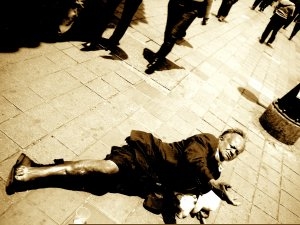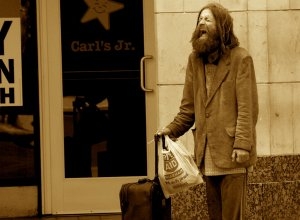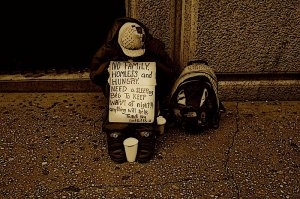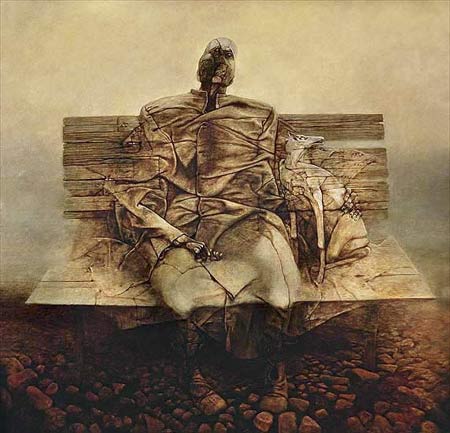 BY JEFF DEENEY The Inquirer’s first attempt at serious homelessness coverage in a long time, imaginatively titled “Homelessness in Philadelphia,” saw the first of its three parts run in the Sunday paper. You might remember back in November that I took a swipe at Inky writers Jennifer Lin and Joseph Slobodzian for peddling the same weak sauce the Inky usually peddles when it comes to homelessness and linked to a hard hitting series by the Boston Globe that did it right and won accolades. Imagine this: four months later Lin and Slobodzian return with a series just like the Globe’s that takes a harder look at Philadelphia’s homeless problem.
BY JEFF DEENEY The Inquirer’s first attempt at serious homelessness coverage in a long time, imaginatively titled “Homelessness in Philadelphia,” saw the first of its three parts run in the Sunday paper. You might remember back in November that I took a swipe at Inky writers Jennifer Lin and Joseph Slobodzian for peddling the same weak sauce the Inky usually peddles when it comes to homelessness and linked to a hard hitting series by the Boston Globe that did it right and won accolades. Imagine this: four months later Lin and Slobodzian return with a series just like the Globe’s that takes a harder look at Philadelphia’s homeless problem.
I was told by some folks who head up some of the initiatives covered in the series that this article was set to run back in December. I think in the intervening months there was fear in some homeless services circles that the article would be put on permanent “work in progress” status while the Inky went back to lobbing the same old softballs. So, some initial kudos to the Inky for persisting with the article and to Lin and Slobodzian for getting back out there and taking another swing at it.
The timing of this series makes it almost impossible not to draw parallels between it and the depiction of newspaper coverage of homelessness in this season of the Wire. In fact, I was all set to write up an analysis of the Wire’s depiction of homelessness so I figure we might as well kill two birds with one stone. The parallel between the Wire’s portrayal and the Inky’s reality is how shockingly disconnected news reporters are today from the streets of the city that they report on.
In The Wire, we see the klutzy, excruciatingly white-bread reporter Scott Templeton tasked with interviewing homeless people about a series of murders. He doesn’t even know where to look for homeless people to interview, and after he’s finally led by the nose to an encampment he has no idea how to proceed with getting his story because he’s clearly terrified of the people he’s been assigned to and inexperienced at interacting with homeless people. I recounted a similar, astonishing encounter with an Inquirer reporter the last time I took them to task; I was staffing the phone at the homeless day center where I then worked and got an incredulous phone call from 400 North Broad asking, “Do you know there are people LIVING ON THE PARKWAY?!”
homeless people about a series of murders. He doesn’t even know where to look for homeless people to interview, and after he’s finally led by the nose to an encampment he has no idea how to proceed with getting his story because he’s clearly terrified of the people he’s been assigned to and inexperienced at interacting with homeless people. I recounted a similar, astonishing encounter with an Inquirer reporter the last time I took them to task; I was staffing the phone at the homeless day center where I then worked and got an incredulous phone call from 400 North Broad asking, “Do you know there are people LIVING ON THE PARKWAY?!”
Dude. Come on. That shit is so weak. They’ve been there for fifteen years, and it’s not like the Youth Study Center is in some remote part of North Philly. It’s right under your nose.
Unfortunately, I feel like elements of this first part of the Inquirer’s series still reflect that Scott Templetonian clunky unfamiliarity with a street setting. There’s very little input here from anyone actually living on the streets. You know why? Because guys living on the streets generally don’t like people in neckties and pantsuits that they don’t know asking them personal questions and scribbling on a notepad while they do it.
A good portion of this first segment focuses on “Charlene,” a faceless woman in a makeshift shelter who we never actually see, nor hear from. There’s a picture of her shelter accompanying the article online, but we don’t see her. This last part is still typical of the Inky’s poor homelessness coverage. For some reason they’re enamored with pictures of dudes passed out face down on steam grates and ramshackle shelters constructed from arbitrary garbage. I guess this singular focus on the most sensational aspects of homelessness highlights the “Dickensian aspect” of street life.
 You can get a homeless person like Charlene’s story, and most stories told to me by the homeless people I’ve worked with are worth hearing, but you can’t get it in one afternoon. You need to keep showing your face out there, people need to feel like they know and trust you before they talk to you. I know this because I’ve done street outreach work and have experienced the relationship building that can be done with the chronically homeless once they recognize your face and know that you actually give a shit about them. There’s a chance “Charlene” would have had something to say if someone tried a little harder to hear her story. Unfortunately, in the “do more with less” world of print journalism, keeping feet on the streets to really get these stories isn’t feasible, much to the detriment of the paper’s content.
You can get a homeless person like Charlene’s story, and most stories told to me by the homeless people I’ve worked with are worth hearing, but you can’t get it in one afternoon. You need to keep showing your face out there, people need to feel like they know and trust you before they talk to you. I know this because I’ve done street outreach work and have experienced the relationship building that can be done with the chronically homeless once they recognize your face and know that you actually give a shit about them. There’s a chance “Charlene” would have had something to say if someone tried a little harder to hear her story. Unfortunately, in the “do more with less” world of print journalism, keeping feet on the streets to really get these stories isn’t feasible, much to the detriment of the paper’s content.
Part two and three will probably be a lot better, because from what I was told by the participating agencies the Inquirer will have personal stories of overcoming homelessness spoon fed to them by case managers who worked directly with the homeless people in question. The case manager can broker a quick trust agreement with the client for the reporter that they wouldn’t otherwise be capable of building organically. Most Philly journos I’ve watched at work are better at these kinds of controlled interactions in formalized, pre-arranged meetings than they are at pounding pavement on the front lines.
One of the two remaining parts of the series will focus on SafeHome Philadelphia, which is a new “housing first” initiative for families run by the Philadelphia Committee to End Homelessness. I used to work for SafeHome, and the Today I Saw series started while I was in the field working with families that were coming out of homelessness, or were on the verge of homelessness and were spared the family shelter system through the agency’s efforts.
The Executive Director of SafeHome/PCEH is Phyllis Ryan, a longtime trench level advocate who took tremendous risks in opening this new program. She’s a perennial outsider in a city of insiders, and this has allowed her to be an outspoken critic of the city homeless services machine that is about as dysfunctional now as it ever has been. Philadelphia needs people like Phyllis, that don’t cater to incumbents to get the inside track on funding and housing deals. However, this means SafeHome relies entirely on private funding sources like donations and grants and they’re trying to do big things with a smaller budget than most (sound familiar, Inky?).
tremendous risks in opening this new program. She’s a perennial outsider in a city of insiders, and this has allowed her to be an outspoken critic of the city homeless services machine that is about as dysfunctional now as it ever has been. Philadelphia needs people like Phyllis, that don’t cater to incumbents to get the inside track on funding and housing deals. However, this means SafeHome relies entirely on private funding sources like donations and grants and they’re trying to do big things with a smaller budget than most (sound familiar, Inky?).
So, along with comments on the remaining two parts of the Inky series, we’re running this link to SafeHome’s donation page. Microdonations like $5 and $10 make a difference for an independent agency like SafeHome. If 100 people give $5 that means SafeHome has $500 dollars that they can use to help their families feed, clothe and shelter their kids. This isn’t blackhole donating, where you have no idea where your dollar will wind up. When you give to SafeHome, that money is going to get spent directly on basic necessities in Philadelphia’s poorest communities. You can see a picture of one of my favorite former clients Runell McKnight and her gorgeous children if you flip forward to slide 22 of the Inky’s “Faces of the Homeless” online slideshow. Also, a shout out to Robert Johnson in slide 17; he was a great volunteer around the office and all around sweetheart who used to help us with the envelope stuffing and stamp licking required to keep a privately funded, grassroots effort like SafeHome afloat.
ABOUT THE AUTHOR: Jeff Deeney is a freelance writer whose work has appeared in PW, City Paper and the Inquirer. He focuses on issues of urban poverty and drug culture.

